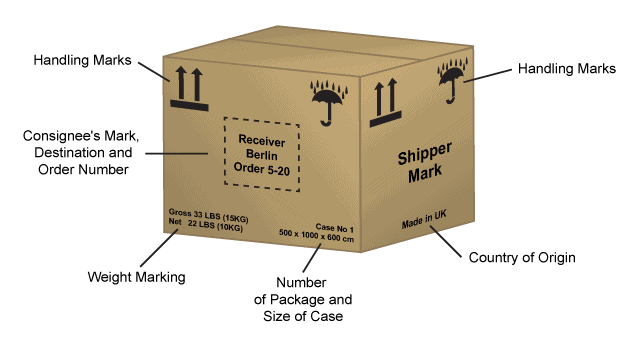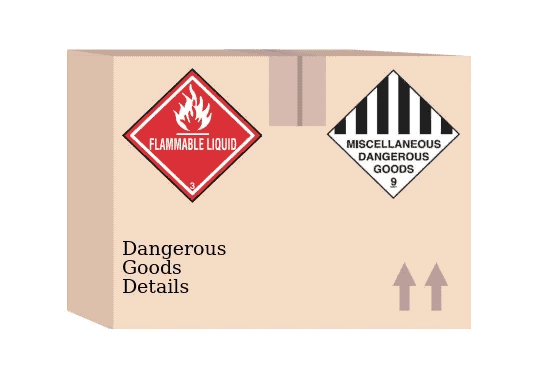It is obviously critical for personnel handling cargo in the major industry of shipping to be able to understand what they are dealing with and take the required precautions to ensure safety and convenience of conveyance. Every day, millions of parcels pass through some transit hubs, and it’s critical not to get lost among them.
There are numerous tools available to assist warehouse operators and couriers in determining what package is in front of them. It is critical to offer a shipping marks template that shows the handler what type of product is present within the shipping carton used, to pack the goods in order to ensure that the handlers can identify the cargo.
What is a Shipping Mark:

Ship marks are identifying words, numbers, or symbols placed on freight to signify the consignee, destination, weight, and related information. To avoid delivery accidents, losses, customs penalties, or damage caused by incorrect storage or handling, the global trade practice assumes that each shipping unit must be clearly and efficiently marked with the required shipping marks.
To begin with, they serve as identity markers for carriers and anybody involved in the carriage and handling of goods while in transit.
Second, the consignee uses them to identify the related order and check that it is delivered correctly.
Why the need for Shipping Marks?
As shipping labels are instructions for the person handling your goods, your boxes must be precisely labeled when shipping. Before unloading a truck or loading a container for delivery, the employees should be aware of the contents. Is it fragile or do the contents need to keep a certain way up? How heavy is it going to be?
Remember that your products are in boxes, so customers won’t know what they are or what measures they need to take when shipping them right away. Handlers must be able to identify the type of product they are handling and the safety and efficiency precautions that must be taken.
Important Points to be Added on the Shipping Mark Label:
The following is a list of information that should be included:
- The name and/or logo of the purchaser
- Order number and/or product reference
- Destination country
- Other pertinent product information: season, size, color, or a breakdown of the many sorts of goods contained within a given carton.
- The carton’s dimensions
- Carton quantity
Types Of Shipping Marks:
There are several types of shipping marks that must be present on your boxes. These identification labels give crucial information for carrying and handling, as well as identifying the consignee.
These include:

1. Handling Marks
These are visual markers that give those who load, unload, or transfer your carton guidance on how to handle it.
Since your shipment may be handled by employees from diverse backgrounds who don’t understand your language, so it’s critical that the markings are visible.

2. Marks of the Consignee
You’ll want to add your company name and logo, as well as specifics like the product name, order number, and so on, as the consignee.
You’ll need to familiarise yourself with Amazon FBA, target, or Walmart policies if these cartons are heading to a retailer (such as Target or Walmart) or an eCommerce platform (such as Amazon FBA). They will provide you carton marking requirements that you must strictly adhere to.
Failure to do so may result in chargebacks, and margins in retail are often razor-thin.
3. Size and Carton Number Markings
You’ll need to number your cartons in order to ensure that they all arrive at the port together.
Indicate the total number of cartons in order and assign a number to each one individually. This should be written in the format “Carton No. of .” Include the carton dimensions, such as “ x x cm” as well.
4. Weight Labels
- It is critical that the weight of each carton be precisely identified in your import documentation.
- One of the most common causes of customs delays in the United States is failing to do so.
- It’s also critical that the intended weight be printed on the carton itself.
- The following information should be included on each carton: Net Weight and Gross Weight.
- Third-party inspection companies must also check carton weight as this can assist you to prevent a weight discrepancy between what’s listed on the carton and what it actually weighs.
5. Markings for the Country of Origin
Your container, like your items, should be labeled with the country of origin.
This information must be printed on each and every carton that is supplied to you, whether they are Made in China or Singapore and so on.
Which Document should not include Shipping Mark:
Except for the letter of credit number, the bill of exchange shall not cover any shipping marks.
The format of a bill of exchange is defined by local legislation, and it is a negotiable instrument.
In terms of acknowledged local law, any irrelevant reference in the bill of exchange may render the document worthless. As a result, exporters must not mark their bills of exchange with any shipping marks.
Shipping Marks in LCL Shipments:
Your products will be placed into a shared container with other orders when transporting cargo that is less than container load (LCL).
Even though LCL shipping is a time- and cost-effective method of delivery, searching through all of the products inside the container to find the right one might be difficult.
Symbols for Transit Packaging:
Symbols, rather than words, should be used for safety and transit-related markings because they are generally recognized. When sending goods worldwide, it’s highly probable that they’ll come across people who don’t speak the language your markings are written in, thus employing symbols to communicate the conditions in which things must be preserved when delivered is critical.
If you’re shipping dangerous goods that fit into one of the nine categories, ensure your containers are properly labeled with the appropriate hazard symbols. This is due to the fact that dangerous goods products can be unstable in transportation due to responses caused by transport conditions. Products that aren’t obviously dangerous in and of themselves must be handled with caution.

Rules to be followed while Shipping Marking:
There are a few essential shipping mark rules that must be followed by all parties involved.
- The port and identification markers that specify the destination and transfer locations should be put on three sides of the package using a stencil and waterproof ink in a large clear font.
- The shipping mark should contain coded marks rather than trade names to help ensure that handlers are less aware of the contents and, as a result, the items are less vulnerable to theft. The codes should be changed on a regular basis to avoid handlers becoming too comfortable with them.
- If the shipment necessitates any particular handling or treatment, the shipping marks should reflect this information on the bill of lading.
- All shipping warning labels must be permanent and easily readable.
- Most freight transportation would necessitate some amount of handling at the destination, so it would be reasonable to print the handling instructions in the destination country’s language on the exterior of the shipping crates or cardboard boxes.
Amazon FBA Marking:
Additional labels will need to be placed on the cartons if your items are being shipped directly to Amazon FBA.
We strongly advise having your supplier use the Amazon carton labels to avoid any additional charges or hassles in the UK. This is due to Amazon’s rigorous packing and labeling standards for acceptance into the warehouse.
Please make sure that any carton labels do not hide the Shipping or Handling marks, or they will be useless!
